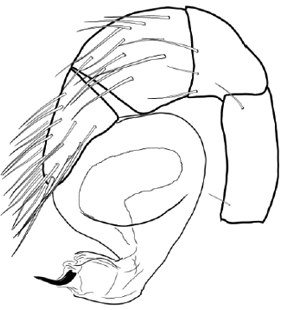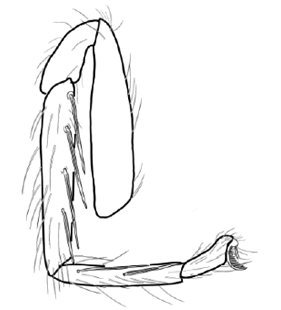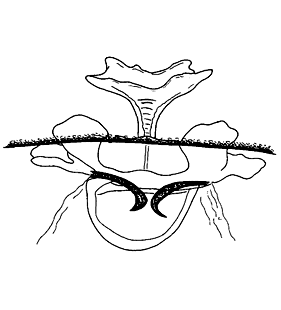Oonops procerus Simon, 1882
Description
Male
Palp: bulb large, pear-shaped, embolus short, strongly widened at the top, forming a cylindrical lobe. Legs: femur I without spines.
Body length male: 2-2.24 mmFemale
Vulva with 2 strong grooves on the surface of the epigyne. Prosoma light brownish-red. Eyes large, subequal. Clypeus a little more narrow than anterior eyes. Legs light grey-yellow, femur broad and flat, tibia I and II with 4 pairs of strong ventral spines, metatarsus I and II with 2 pairs of strong ventral spines, femur I with 3 or 4 prolateral spines, femur II, III and IV with only one dorsal spine, tibia and metatarsus III and IV with 2 pairs of lateral and 2 pairs of ventral spines. Opisthosoma oblong oval, bright orange-red. Cuticula with sparse strong hairs.
Body length female: 2.6-2.8 mmAdditional information
In fresh or dry habitats, decisuous, coniferous or mixed forests, among litter and moss, or under stones.
Distribution
Phenology
| Jan | Feb | Mar | Apr | May | Jun | Jul | Aug | Sep | Oct | Nov | Dec |
 |  |
Figures
Distribution List
"No references" does not mean that the species does not occur in this country, but that we have not yet inserted the reference for it. We are working on it.
References
Branco V V, Morano E, Cardoso P (2019) An update to the Iberian spider checklist (Araneae). Zootaxa 4614: 201-254 ![]()
Breitling R (2020) South European spiders from the Duffey collection in the Manchester Museum (Arachnida: Araneae). Arachnology 18: 333-362 ![]()
Duffey E, Brignoli P M (1981) Two rare spiders from the Spanish Pyrenees (prov. Huesca). Bulletin of the British Arachnological Society 5: 155-158 ![]()
Le Peru B (2011) The spiders of Europe, a synthesis of data: Volume 1 Atypidae to Theridiidae. Mémoires de la Société Linnéenne de Lyon 2: 1-522 ![]()
WSC (2025) World Spider Catalog. Version 26. Natural History Museum Bern, online at http://wsc.nmbe.ch (28.2.2025) doi: 10.24436/2 ![]()
Updates
| 25-07-2020 | Image insert | |
| 10-12-2013 | Image insert |





